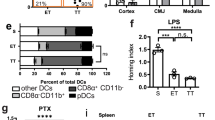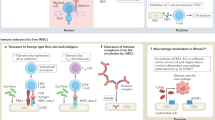Abstract
Chemokines presented by the endothelium are critical for integrin-dependent adhesion and transendothelial migration of naive and memory lymphocytes. Here we found that effector lymphocytes of the type 1 helper T cell (TH1 cell) and type 1 cytotoxic T cell (TC1 cell) subtypes expressed adhesive integrins that bypassed chemokine signals and established firm arrests on variably inflamed endothelial barriers. Nevertheless, the transendothelial migration of these lymphocytes strictly depended on signals from guanine nucleotide–binding proteins of the Gi type and was promoted by multiple endothelium-derived inflammatory chemokines, even without outer endothelial surface exposure. Instead, transendothelial migration–promoting endothelial chemokines were stored in vesicles docked on actin fibers beneath the plasma membranes and were locally released within tight lymphocyte-endothelial synapses. Thus, effector T lymphocytes can cross inflamed barriers through contact-guided consumption of intraendothelial chemokines without surface-deposited chemokines or extraendothelial chemokine gradients.
This is a preview of subscription content, access via your institution
Access options
Subscribe to this journal
Receive 12 print issues and online access
$209.00 per year
only $17.42 per issue
Buy this article
- Purchase on Springer Link
- Instant access to full article PDF
Prices may be subject to local taxes which are calculated during checkout








Similar content being viewed by others
References
Campbell, J.J. & Butcher, E.C. Chemokines in tissue-specific and microenvironment-specific lymphocyte homing. Curr. Opin. Immunol. 12, 336–341 (2000).
Ley, K., Laudanna, C., Cybulsky, M.I. & Nourshargh, S. Getting to the site of inflammation: the leukocyte adhesion cascade updated. Nat. Rev. Immunol. 7, 678–689 (2007).
Thelen, M. & Stein, J.V. How chemokines invite leukocytes to dance. Nat. Immunol. 9, 953–959 (2008).
Shulman, Z. et al. Lymphocyte crawling and transendothelial migration require chemokine triggering of high-affinity LFA-1 integrin. Immunity 30, 384–396 (2009).
Schreiber, T.H., Shinder, V., Cain, D.W., Alon, R. & Sackstein, R. Shear flow-dependent integration of apical and subendothelial chemokines in T-cell transmigration: implications for locomotion and the multistep paradigm. Blood 109, 1381–1386 (2007).
Carman, C.V. et al. Transcellular diapedesis is initiated by invasive podosomes. Immunity 26, 784–797 (2007).
Ravkov, E.V., Myrick, C.M. & Altman, J.D. Immediate early effector functions of virus-specific CD8+CCR7+ memory cells in humans defined by HLA and CC chemokine ligand 19 tetramers. J. Immunol. 170, 2461–2468 (2003).
Shiow, L.R. et al. CD69 acts downstream of interferon-α/β to inhibit S1P1 and lymphocyte egress from lymphoid organs. Nature 440, 540–544 (2006).
von Andrian, U.H. & Mackay, C.R. T-cell function and migration. Two sides of the same coin. N. Engl. J. Med. 343, 1020–1034 (2000).
Masopust, D. et al. Activated primary and memory CD8 T cells migrate to nonlymphoid tissues regardless of site of activation or tissue of origin. J. Immunol. 172, 4875–4882 (2004).
Bromley, S.K., Mempel, T.R. & Luster, A.D. Orchestrating the orchestrators: chemokines in control of T cell traffic. Nat. Immunol. 9, 970–980 (2008).
Xie, H., Lim, Y.C., Luscinskas, F.W. & Lichtman, A.H. Acquisition of selectin binding and peripheral homing properties by CD4+ and CD8+ T cells. J. Exp. Med. 189, 1765–1776 (1999).
Siegelman, M.H., Stanescu, D. & Estess, P. The CD44-initiated pathway of T-cell extravasation uses VLA-4 but not LFA-1 for firm adhesion. J. Clin. Invest. 105, 683–691 (2000).
Warnock, R.A., Askari, S., Butcher, E.C. & von Andrian, U.H. Molecular mechanisms of lymphocyte homing to peripheral lymph nodes. J. Exp. Med. 187, 205–216 (1998).
Shulman, Z. & Alon, R. Real-time in vitro assays for studying the role of chemokines in lymphocyte transendothelial migration under physiologic flow conditions. Methods Enzymol. 461, 311–332 (2009).
McKinstry, K.K. et al. Rapid default transition of CD4 T cell effectors to functional memory cells. J. Exp. Med. 204, 2199–2211 (2007).
Lim, Y.C. et al. α4 β1-integrin activation is necessary for high-efficiency T-cell subset interactions with VCAM-1 under flow. Microcirculation 7, 201–214 (2000).
Constantin, G. et al. Chemokines trigger immediate β2 integrin affinity and mobility changes: differential regulation and roles in lymphocyte arrest under flow. Immunity 13, 759–769 (2000).
Beals, C.R., Edwards, A.C., Gottschalk, R.J., Kuijpers, T.W. & Staunton, D.E. CD18 activation epitopes induced by leukocyte activation. J. Immunol. 167, 6113–6122 (2001).
Bolomini-Vittori, M. et al. Regulation of conformer-specific activation of the integrin LFA-1 by a chemokine-triggered Rho signaling module. Nat. Immunol. 10, 185–194 (2009).
Fagerholm, S.C., Hilden, T.J., Nurmi, S.M. & Gahmberg, C.G. Specific integrin α and β chain phosphorylations regulate LFA-1 activation through affinity-dependent and -independent mechanisms. J. Cell Biol. 171, 705–715 (2005).
Baker, R.G. & Koretzky, G.A. Regulation of T cell integrin function by adapter proteins. Immunol. Res. 42, 132–144 (2008).
Hogg, N., Patzak, I. & Willenbrock, F. The insider's guide to leukocyte integrin signalling and function. Nat. Rev. Immunol. 11, 416–426 (2011).
Atarashi, K., Hirata, T., Matsumoto, M., Kanemitsu, N. & Miyasaka, M. Rolling of Th1 cells via P-selectin glycoprotein ligand-1 stimulates LFA-1-mediated cell binding to ICAM-1. J. Immunol. 174, 1424–1432 (2005).
Cinamon, G., Shinder, V. & Alon, R. Shear forces promote lymphocyte migration across vascular endothelium bearing apical chemokines. Nat. Immunol. 2, 515–522 (2001).
Woolf, E. et al. Lymph node chemokines promote sustained T lymphocyte motility without triggering stable integrin adhesiveness in the absence of shear forces. Nat. Immunol. 8, 1076–1085 (2007).
Zhang, H.H. et al. CCR2 identifies a stable population of human effector memory CD4+ T cells equipped for rapid recall response. J. Immunol. 185, 6646–6663 (2010).
Cinamon, G., Shinder, V., Shamri, R. & Alon, R. Chemoattractant signals and β2 integrin occupancy at apical endothelial contacts combine with shear stress signals to promote transendothelial neutrophil migration. J. Immunol. 173, 7282–7291 (2004).
Hillyer, P., Mordelet, E., Flynn, G. & Male, D. Chemokines, chemokine receptors and adhesion molecules on different human endothelia: discriminating the tissue-specific functions that affect leucocyte migration. Clin. Exp. Immunol. 134, 431–441 (2003).
Bao, X. et al. Endothelial heparan sulfate controls chemokine presentation in recruitment of lymphocytes and dendritic cells to lymph nodes. Immunity 33, 817–829 (2010).
Øynebråten, I., Bakke, O., Brandtzaeg, P., Johansen, F.E. & Haraldsen, G. Rapid chemokine secretion from endothelial cells originates from 2 distinct compartments. Blood 104, 314–320 (2004).
Øynebråten, I. et al. Characterization of a novel chemokine-containing storage granule in endothelial cells: evidence for preferential exocytosis mediated by protein kinase A and diacylglycerol. J. Immunol. 175, 5358–5369 (2005).
Klausner, R.D., Donaldson, J.G. & Lippincott-Schwartz, J. Brefeldin A: insights into the control of membrane traffic and organelle structure. J. Cell Biol. 116, 1071–1080 (1992).
Mamdouh, Z., Mikhailov, A. & Muller, W.A. Transcellular migration of leukocytes is mediated by the endothelial lateral border recycling compartment. J. Exp. Med. 206, 2795–2808 (2009).
Middleton, J. et al. Transcytosis and surface presentation of IL-8 by venular endothelial cells. Cell 91, 385–395 (1997).
Palframan, R.T. et al. Inflammatory chemokine transport and presentation in HEV: a remote control mechanism for monocyte recruitment to lymph nodes in inflamed tissues. J. Exp. Med. 194, 1361–1373 (2001).
Pruenster, M. et al. The Duffy antigen receptor for chemokines transports chemokines and supports their promigratory activity. Nat. Immunol. 10, 101–108 (2009).
Guarda, G. et al. L-selectin-negative CCR7-effector and memory CD8+ T cells enter reactive lymph nodes and kill dendritic cells. Nat. Immunol. 8, 743–752 (2007).
Wolf, M., Albrecht, S. & Marki, C. Proteolytic processing of chemokines: implications in physiological and pathological conditions. Int. J. Biochem. Cell Biol. 40, 1185–1198 (2008).
Sauty, A. et al. The T cell-specific CXC chemokines IP-10, Mig, and I-TAC are expressed by activated human bronchial epithelial cells. J. Immunol. 162, 3549–3558 (1999).
Park, J.J. & Loh, Y.P. How peptide hormone vesicles are transported to the secretion site for exocytosis. Mol. Endocrinol. 22, 2583–2595 (2008).
Rondaij, M.G. et al. Guanine exchange factor RalGDS mediates exocytosis of Weibel-Palade bodies from endothelial cells. Blood 112, 56–63 (2008).
Pober, J.S. & Sessa, W.C. Evolving functions of endothelial cells in inflammation. Nat. Rev. Immunol. 7, 803–815 (2007).
Soehnlein, O., Lindbom, L. & Weber, C. Mechanisms underlying neutrophil-mediated monocyte recruitment. Blood 114, 4613–4623 (2009).
Jamieson, T. et al. The chemokine receptor D6 limits the inflammatory response in vivo. Nat. Immunol. 6, 403–411 (2005).
Proudfoot, A.E. The biological relevance of chemokine-proteoglycan interactions. Biochem. Soc. Trans. 34, 422–426 (2006).
Grabovsky, V. et al. Subsecond induction of α4 integrin clustering by immobilized chemokines stimulates leukocyte tethering and rolling on endothelial vascular cell adhesion molecule 1 under flow conditions. J. Exp. Med. 192, 495–506 (2000).
Proudfoot, A.E. et al. Amino-terminally modified RANTES analogues demonstrate differential effects on RANTES receptors. J. Biol. Chem. 274, 32478–32485 (1999).
Acknowledgements
We thank R. Wedlich-Soeldner (Max-Planck Institute for Biochemistry) for Lifeact-mRFP; A. Bershadsky (Weizmann Institute) for α-tubulin–mCherry; B. Geiger (Weizmann Institute) for paxillin-CFP; F. Sanchez-Madrid (Universidad Autónoma de Madrid) for ICAM-1-EGFP; Y. Kloog (Tel-Aviv University) for eGFP-th; R. Pardi (Dibit-Scientific Institute San Raffaele) for Rab11-DsRed; G. Shakhar and M. Fernandez-Borja for discussions, and S. Schwarzbaum for editorial assistance. Supported by The Linda Jacobs Chair in Immune and Stem Cell Research (R.A.), the Israel Science Foundation (R.A.), the Minerva Foundation, the Flight Attendant Medical Research Institute Foundation (R.A.) and the Germany-Israel Science Foundation (R.A.).
Author information
Authors and Affiliations
Contributions
Z.S. designed the in vitro models, did most of the experiments and wrote parts of the manuscript; S.J.C. designed and did major parts of Figures 1 and 5b, and Supplementary Figures 2 and 3; B.R.,V.K. and R.J. did multiphoton intravital imaging; V.G. and L.S.-B. did flow chamber studies; S.W.F. did flow chamber experiments, biochemistry and data organization; E.K. and V.S. did EM analysis; T.M. did chemokine-GFP cloning; S.M.N. did LFA-1 phosphorylation analysis; I.G. did TH1-TC1 analysis; O.H. did GPCR blocker synthesis; C.G.G., A.E., W.W. and A.B.-B. supervised specific parts of the research; and R.A. designed the study, supervised the work and wrote the manuscript.
Corresponding author
Ethics declarations
Competing interests
The authors declare no competing financial interests.
Supplementary information
Supplementary Text and Figures
Supplementary Figures 1–14 and Methods (PDF 5527 kb)
Supplementary Video 1
Intravital microscopy of OT-1 effectors interacting with skin vessels in a sterile inflammed ear model. (MOV 3277 kb)
Supplementary Video 2
Crawling of a PTX-pretreated CD3 effector on a CFA inflamed skin vessel. (MOV 419 kb)
Supplementary Video 3
The major TEM route of effectors is through endothelial junctions. (MOV 2884 kb)
Supplementary Video 4
Transendothelial migration but not apical crawling of effector lymphocytes requires chemokine signals. (MOV 4131 kb)
Supplementary Video 5
Formation of subluminal leading edge by effector lymphocytes requires endothelial based chemokine signals. (MOV 8652 kb)
Supplementary Video 6
Effector lymphocytes can cross the endothelium through paracellular and transcellular TEM routes. (MOV 9032 kb)
Supplementary Video 7
CCL2 containing vesicles are not recycling endosomes. (MOV 3796 kb)
Supplementary Video 8
CCL2 vesicles are mobilized on microtubules and docked on actin fibers in inflamed endothelial cells. (MOV 4883 kb)
Supplementary Video 9
CCL2 vesicles interaction with endothelial cytoskeleton. (MOV 3861 kb)
Supplementary Video 10
Treatment of endothelial cells with microtubules disrupting agent, halt vesicle motility. (MOV 4394 kb)
Supplementary Video 11
Disruption of actin filaments impairs chemokine vesicle docking without altering rapid vesicle motility. (MOV 4967 kb)
Supplementary Video 12
The basolateral leading edge of effector lymphocytes consumes vesicle stored CCL2 during productive TEM. (MOV 6138 kb)
Supplementary Video 13
Sticking of PTX-pretreated CD3 effectors on a CFA inflamed skin vessel. (MOV 796 kb)
Rights and permissions
About this article
Cite this article
Shulman, Z., Cohen, S., Roediger, B. et al. Transendothelial migration of lymphocytes mediated by intraendothelial vesicle stores rather than by extracellular chemokine depots. Nat Immunol 13, 67–76 (2012). https://doi.org/10.1038/ni.2173
Received:
Accepted:
Published:
Issue Date:
DOI: https://doi.org/10.1038/ni.2173
This article is cited by
-
Nectins and Nectin-like molecules drive vascular development and barrier function
Angiogenesis (2023)
-
Adenosine A2A receptor controls the gateway of the choroid plexus
Purinergic Signalling (2023)
-
ST3GAL1 and βII-spectrin pathways control CAR T cell migration to target tumors
Nature Immunology (2023)
-
Human CD4+ T cell subsets differ in their abilities to cross endothelial and epithelial brain barriers in vitro
Fluids and Barriers of the CNS (2020)
-
Biomimetic post-capillary venule expansions for leukocyte adhesion studies
Scientific Reports (2018)



